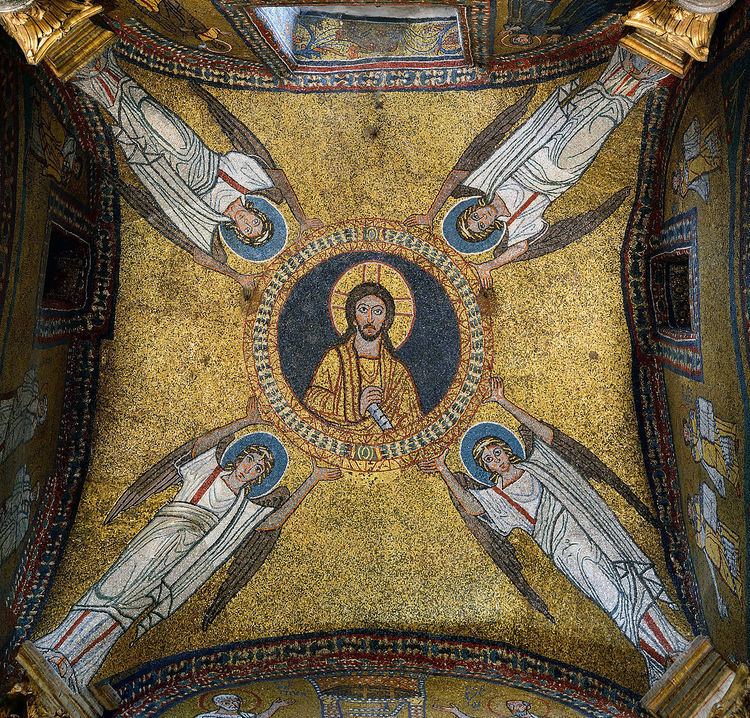Ecclesiastical or organizational status Minor basilica Completed 822 Width 30 m | Groundbreaking 780 Length 45 m Phone +39 06 488 2456 Architectural type Church | |
 | ||
Website Chiesa Rettoria Santa Prassede Similar Santa Pudenziana, Basilica di Santa Maria Ma, Basilica of San Clemente, Santa Maria in Trastevere, San Pietro in Vincoli | ||
Santa prassede praxedes
The Basilica of Saint Praxedes (Latin: Basilica Sanctae Praxedis, Italian: Basilica di Santa Prassede all’Esquillino), commonly known in Italian as Santa Prassede, is an ancient titular church and minor basilica in Rome, Italy, located near the papal basilica of Saint Mary Major. The current Cardinal Priest of Titulus Sancta Praxedis is Paul Poupard.
Contents
History
The church in its current form was commissioned by Pope Hadrian I around the year 780, and built on top of the remains of a 5th-century structure and was designed to house the bones of Saint Praxedes (Italian: S. Prassede) and Saint Pudentiana (Italian: S. Pudenziana), the daughters of Saint Pudens, traditionally St. Peter's first Christian convert in Rome. The two female saints were murdered for providing Christian burial for early martyrs in defiance of Roman law. The basilica was enlarged and decorated by Pope Paschal I in c. 822.
Pope Paschal, who reigned 817-824, was at the forefront of the Carolingian Renaissance started and advocated by the emperor Charlemagne. They desired to get back to the foundations of Christianity theologically and artistically. Paschal, thus, began two, linked, ambitious programs: the recovery of martyrs' bones from the catacombs of Rome and an almost unprecedented church building campaign. Paschal dug up numerous skeletons and transplanted them to this church. The Titulus S. Praxedis was established by Pope Evaristus, around 112.
The inscriptions found in Santa Prassede, a valuable source illustrating the history of the church, have been collected and published by Vincenzo Forcella.
The church provided the inspiration for Robert Browning's poem "The Bishop Orders His Tomb at Saint Praxed's Church."
Interior
The main altarpiece is a canvas of St Praxedes Gathering the Blood of the Martyrs (c. 1730-35) by Domenico Muratori.
Mosaic
The most famous element of the church is the mosaic decorative program. Paschal hired a team of professional mosaicists to complete the work in the apse, the apsidal arch, and the triumphal arch. In the apse, Jesus is in the center, flanked by Sts. Peter and Paul who present Prassede and Pudenziana to God. On the far left is Paschal, with the square halo of the living, presenting a model of the church as an offering to Jesus. Below runs an inscription of Paschal's, hoping that this offering will be sufficient to secure his place in heaven.
On the apsidal arch are twelve men on each side, holding wreaths of victory, welcoming the souls into heaven. Above them are symbols of the four Gospel writers: Mark, the lion; Matthew, the man; Luke, the bull; and John, the eagle, as they surround a lamb on a throne, a symbol of Christ's eventual return to Earth.
Those mosaics, as well as those in the Chapel of Saint Zeno, a funerary chapel which Pope Paschal built for his mother, Theodora, are the best-known aspects of the church. Also noteworthy are ancient frescoes. Ascending a spiral staircase, one enters a small room, covered in scaffolding; on the wall is a fresco cycle, dating most likely from the 8th century. The frescoes probably depict the life-cycle of the name saint of the church, Praxedes.
Pillar of the Flogging
Santa Prassede also houses an alleged segment of the pillar upon which Jesus was flogged and tortured before his crucifixion in Jerusalem. The relic is alleged to have been retrieved in the early 4th century by Saint Helena (mother of the Roman Emperor Constantine I) who at the age of eighty undertook a pilgrimage to the Holy Land, where she founded churches for Christian worship and collected relics associated with the crucifixion of Jesus on Calvary.
Among these legendary relics retrieved by Helena, which included pieces of the True Cross (now venerated at St. Peter's Basilica with fragments in Santa Croce in Gerusalemme, also in Rome) and wood from the Jesus' crib enshrined at S. Maria Maggiore. The authenticity of these relics, including the Santa Prassede pillar, is disputed by historians and Christians alike, due to lack of forensic evidence and the proliferation of falsified relics during Late Antiquity and the Middle Ages.
Titulus
Among known titulars of this see are Lambertus Scannabecchi (later Pope Honorius II, c. 1099), Ubaldo Allucingoli (later Pope Lucius III, 1141), Alain de Coëtivy (1448), Giovanni Maria Ciocchi del Monte (later Pope Julius III, 1542-1543), Saint Charles Borromeo (1538-1584), Rafael Merry del Val (1903-1930).
